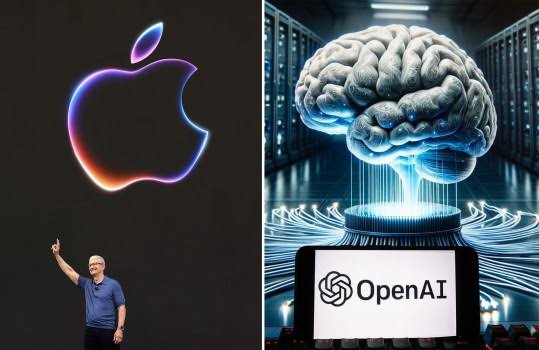Introduction
In a surprising twist, Apple has reportedly backed out of negotiations to participate in a major funding round for OpenAI, the company behind the widely known AI tool ChatGPT. According to a report by The Wall Street Journal (WSJ), Apple pulled the plug at the last minute, ending what could have been a rare investment by the tech giant.
This funding round, expected to raise as much as $6.5 billion, had attracted interest from several tech giants like Microsoft and Nvidia. With Apple’s abrupt exit, the tech community is left wondering why Apple backed out and what this means for OpenAI’s future.
1. Apple’s Sudden Exit from OpenAI Talks
Apple’s sudden decision to withdraw from discussions to invest in OpenAI has caught many by surprise. The funding round, which is expected to close next week, would have been a significant financial injection into OpenAI, helping it expand its AI research and development. According to the WSJ report, Apple was in advanced talks, but decided at the “11th hour” to walk away, leaving the deal table unexpectedly.
2. The $6.5 Billion Funding Round
This isn’t just any investment round—OpenAI aims to raise as much as $6.5 billion from interested parties. Several high-profile companies are reportedly vying for a piece of the action, with Microsoft and Nvidia leading the pack. Microsoft, already a significant investor in OpenAI, is reportedly considering increasing its stake further. The software giant has long been a strategic partner of OpenAI, embedding its AI tools, including ChatGPT, into products like Microsoft 365.
3. Venture Capital and International Interest
While Microsoft and Nvidia are high-profile names, other powerful players are also involved. Venture capital firm Thrive Capital is reportedly leading this funding round, showing strong confidence in OpenAI’s future. Thrive Capital’s involvement is no surprise, as it has been a major player in backing tech companies with high growth potential.
Additionally, other prominent names, such as Tiger Global Management and MGX (a United Arab Emirates state-backed entity), are also in discussions to contribute to the funding round. This shows that OpenAI is attracting global attention, with investors from different regions recognizing the potential of AI in shaping the future of technology.
4. OpenAI’s Transformation from Nonprofit to For-Profit
A key aspect of this funding round is the ongoing transformation of OpenAI’s corporate structure. Originally established as a nonprofit, OpenAI is transitioning into a for-profit entity. This shift is largely driven by the need to secure large investments, but it comes with its own set of challenges.
The transition is not just a simple restructuring—it’s a process that requires OpenAI to balance its original mission of advancing AI for humanity with the profit-driven goals of its investors. If OpenAI fails to complete this transformation within two years, investors participating in the current round will have the right to ask for their money back. This presents a significant risk for both OpenAI and its investors, making the transition a high-stakes endeavor.

5. Why Did Apple Pull Out?
So why did Apple decide to walk away? There could be several reasons for Apple’s sudden change of heart.
- Strategic Priorities: Apple might have decided that investing in OpenAI doesn’t align with its long-term strategy. Apple has been investing in its own AI capabilities, particularly for use in its devices like Siri, and may not have seen enough strategic benefit in partnering with an external AI player like OpenAI.
- Data Privacy Concerns: Apple is well-known for its focus on user privacy. OpenAI, on the other hand, deals with massive amounts of data to train its AI models. Apple may have had concerns over data privacy and how OpenAI manages its data, which could have led to them pulling out.
- Investment Risks: The risk tied to OpenAI’s transition from nonprofit to for-profit might have been another factor. The complexity of this transformation could create instability, and Apple, known for being cautious, may have decided not to take on that risk.
- Existing Partnerships: Finally, Apple may have been wary of OpenAI’s strong relationship with Microsoft, one of its major competitors. With Microsoft already deeply involved in OpenAI’s operations, Apple might have felt that it would not have enough influence over the company’s direction.
6. What’s Next for OpenAI?
With Apple out of the picture, OpenAI’s funding round still remains on track, thanks to the involvement of major players like Microsoft, Nvidia, and international investors. Microsoft’s increased investment in OpenAI suggests that the tech giant is doubling down on AI as a key component of its future strategy. Nvidia, the leader in GPU technology, is also a crucial player in the AI space, as its hardware powers much of the AI infrastructure globally.
As OpenAI continues its transformation into a for-profit entity, it will need to navigate the challenges of balancing the demands of investors with its original mission of ensuring that AI benefits all of humanity. This transformation, while risky, could help OpenAI scale its operations and continue developing groundbreaking AI technologies.
Conclusion
Apple’s sudden exit from OpenAI’s $6.5 billion funding round has raised questions, but it’s clear that OpenAI remains a hot commodity in the tech world. With major players like Microsoft, Nvidia, and international investors still in the race, OpenAI’s future looks bright, albeit with some challenges ahead.
As the AI landscape continues to evolve, OpenAI’s ability to navigate its transition from nonprofit to for-profit and manage its relationships with investors will be key to its long-term success. Whether Apple will re-enter the AI race with its own innovations or continue to pursue other avenues remains to be seen, but one thing is certain—AI is the future, and companies like OpenAI are at the forefront of this revolution.







